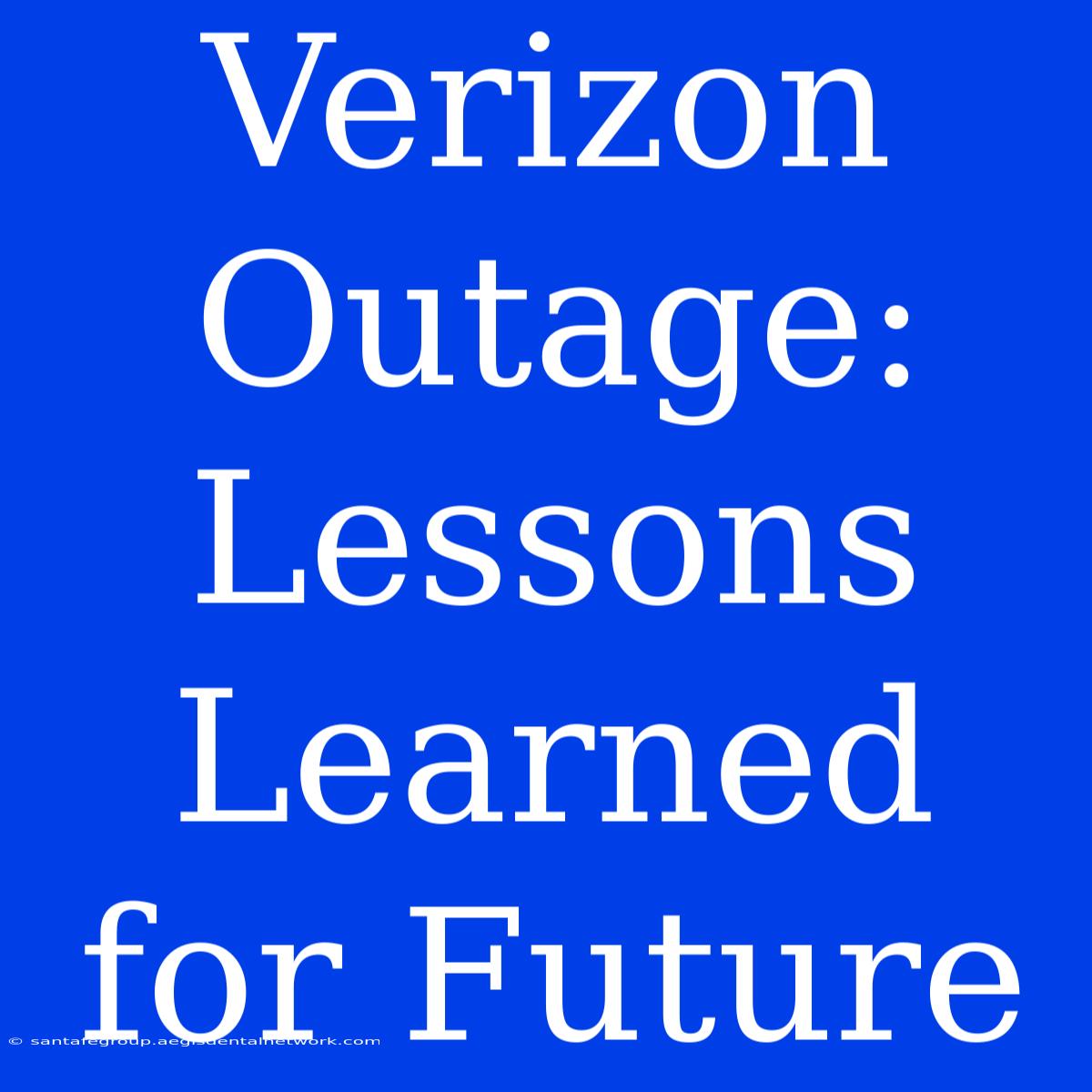Verizon Outage: Lessons Learned for Future Network Resilience
What happened during the Verizon outage? What can we learn from it? The widespread Verizon outage in 2022 caused significant disruption for millions of customers. This event underscored the importance of robust network infrastructure and the need for continuous improvements in network resilience. Verizon outage has become a case study for telecommunication companies globally, prompting them to reassess their network design, security practices, and emergency response protocols.
Editor Note: The Verizon outage served as a stark reminder of the vulnerability of modern communication systems and highlighted the need for proactive strategies to prevent future disruptions. This article examines the key aspects of the Verizon outage and explores crucial lessons learned to enhance network resilience.
Why is this topic important?
This topic is essential because it directly affects our interconnected world. Reliable communication infrastructure is crucial for businesses, emergency services, and daily life. This article explores the Verizon outage's impact on various stakeholders, including consumers, businesses, and government agencies. It analyzes the root causes of the outage and examines related aspects such as network redundancy, disaster recovery planning, network monitoring, and incident response.
Analysis:
This analysis delves into the Verizon outage by reviewing published reports, expert opinions, and industry best practices. It aims to provide a comprehensive overview of the outage, identify its key contributing factors, and suggest concrete steps to mitigate similar events in the future.
Key takeaways of the Verizon Outage:
| Key Takeaway | Description |
|---|---|
| Single Point of Failure | The outage was caused by a failure at a single point in the network, highlighting the importance of redundancy. |
| Lack of Network Visibility | The outage revealed the lack of real-time visibility into network performance, hampering timely detection and resolution. |
| Inadequate Disaster Planning | Insufficient disaster recovery protocols and a lack of effective communication between internal teams slowed down the response. |
| Impact on Critical Services | The outage impacted essential services like emergency communications and financial transactions, demonstrating the need for network resilience. |
Verizon Outage: Lessons Learned
Network Redundancy:
- Introduction: Network redundancy is crucial for ensuring continued operation in case of a failure. This involves designing the network with multiple paths and backup systems to minimize service disruptions.
- Facets:
- Redundant Routing: Utilizing multiple network paths to prevent single points of failure.
- Backup Systems: Implementing redundant equipment and systems, such as backup servers and power sources.
- Geographic Diversity: Distributing network components across different geographical locations to mitigate the impact of regional events.
Disaster Recovery Planning:
- Introduction: Comprehensive disaster recovery plans are essential for ensuring a quick and coordinated response to outages.
- Facets:
- Scenario Planning: Simulating different outage scenarios to identify potential vulnerabilities and refine response strategies.
- Communication Protocols: Establishing clear communication channels for internal teams and external stakeholders.
- Data Backup and Recovery: Implementing robust data backup and recovery procedures to minimize data loss.
Network Monitoring and Analytics:
- Introduction: Continuous monitoring and analytics are essential for detecting and responding to network issues proactively.
- Facets:
- Real-time Monitoring: Utilizing network monitoring tools to track performance metrics and identify anomalies.
- Automated Alerting: Implementing automated alert systems to notify technicians of critical issues promptly.
- Root Cause Analysis: Leveraging data analytics to identify the root causes of network failures and implement preventive measures.
Incident Response:
- Introduction: Effective incident response plans are critical for minimizing the impact of outages.
- Facets:
- Rapid Response: Establishing clear protocols for identifying and responding to network issues.
- Escalation Procedures: Having a clear escalation process to ensure timely engagement of relevant teams.
- Post-mortem Analysis: Conducting comprehensive post-mortem analysis to learn from incidents and improve future response.
Summary:
The Verizon outage highlighted the importance of proactive measures to ensure network resilience. Implementing robust network redundancy, effective disaster recovery plans, continuous monitoring, and comprehensive incident response protocols are essential steps to mitigate future outages and protect critical services.
FAQ:
- Q: What caused the Verizon outage?
- A: The specific cause was a failure at a single point in the network. However, the outage exposed vulnerabilities related to network design, redundancy, and disaster planning.
- Q: What are the lessons learned from the Verizon outage?
- A: The outage emphasized the importance of redundancy, disaster recovery plans, network monitoring, and rapid incident response.
- Q: How can telecommunications companies improve network resilience?
- A: Companies should invest in redundant infrastructure, develop comprehensive disaster recovery plans, implement robust network monitoring tools, and refine incident response procedures.
- Q: What are the consequences of network outages?
- A: Outages can disrupt critical services like emergency communications, financial transactions, and daily business operations.
- Q: What is the role of government regulation in network resilience?
- A: Government regulations can incentivize companies to invest in network infrastructure improvements and establish minimum standards for network resilience.
- Q: What is the future of network resilience?
- A: The future of network resilience involves the adoption of advanced technologies like artificial intelligence (AI), machine learning (ML), and cloud computing to enhance network monitoring, analysis, and automation.
Tips for Improving Network Resilience:
- Implement Network Redundancy: Invest in redundant infrastructure and systems to ensure continuous operation.
- Develop Comprehensive Disaster Recovery Plans: Simulate various scenarios and establish clear communication protocols.
- Invest in Network Monitoring Tools: Utilize real-time monitoring and automated alerting systems to detect issues promptly.
- Refine Incident Response Procedures: Develop clear protocols for escalation, communication, and post-mortem analysis.
- Stay Informed about Industry Best Practices: Continuously evaluate new technologies and best practices to improve network resilience.
Closing Message:
The Verizon outage serves as a critical reminder that robust network resilience is essential for the seamless functioning of our modern society. By investing in the right infrastructure, implementing effective strategies, and staying vigilant, telecommunications companies can ensure a future where communication is reliable, accessible, and resilient in the face of unexpected challenges.

